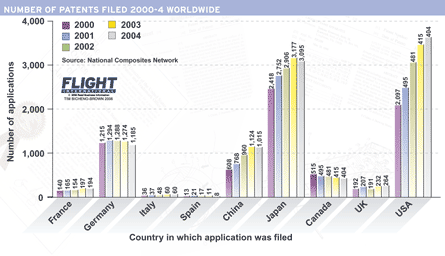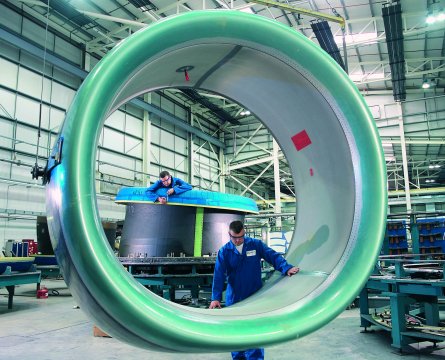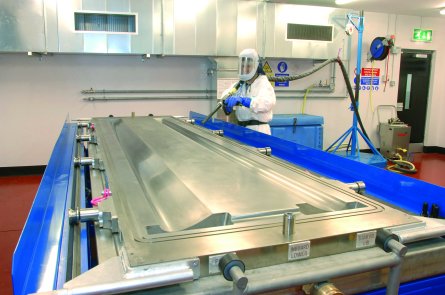By Rob Coppinger in London
In 2004, the UK’s revenues from finished composites parts for all sectors was £800 million ($1.4 billion) – a figure dwarfed by the £11 billion generated by the USA and China’s £13 billion. Within Europe, statistics for the same year show that, while UK does somewhat better, it is still not the leader. Germany generated double the UK’s composites revenue, at £1.6 billion, while France and Italy both earned £1.2 billion each.
|
|
|---|
| Demand for composites in new airliners like the 787 represents a good opportunity to increase market share |
The UK was ahead of Spain in 2004, earning £200 million more from composite parts, but the Spanish are drawing level, and UK industry knows it is going to take the efforts of hundred of companies across the country – and not just wing manufacturer Airbus UK – to close the huge revenue gap with its competitors.
In 2001 over 13% of composites companies were involved in the military and civil aerospace markets. Only construction came close to aerospace, with just over 8%. The data comes from the UK Department of Trade and Industry’s (DTI) polymer composites study, published in October 2001 and the most recent comprehensive industry report. The study, undertaken from April to June 2001, also found that the UK’s problem areas included high labour costs, a shortage of design guides and little applied development. Five years on, Gordon Bishop, managing director at research company NetComposites and co-author of the report, still thinks many of its conclusions are relevant.
Underlying themes
“Aerospace has changed twice since the report, with 9/11 and then the announcements of the Boeing 787 and Airbus A350. But the underlying themes are the same [and now] there is a [worldwide] material shortage,” says Bishop. Demand for composites, carbonfibre in particular, is expected to expand by 50% over the next five to 10 years, representing a good opportunity for countries to increase market share. “Asian countries’ companies are developing composite capabilities, Japan’s Mitsubishi in particular,” he says.
With composites technology seen as so significant worldwide, the UK response was an early decision by the nation’s then new industry/government Aerospace Innovation and Growth Team (AEIGT) to organise bids for national research funds. In the eight years before 2001 the DTI had spent about £1.3 million a year on research, but industry wanted more from government. The AEIGT, created in 2002, published its first report on UK aerospace and its future needs in June 2003. In its technology implementation plan, completed in December of that year, the team recommended that £300 million a year be spent on aerospace research every year by industry and government. This would require a £50 million increase in government spending for civil sector and a redirection of Ministry of Defence funding.
Key areas for this funding, according to the AEIGT, were smart materials and advanced structures. “The AEIGT’s aerospace technology steering group advised that a bid should be put in for composites research. That bid was one of the first to be made,” says Society of British Aerospace Companies (SBAC) civil air transport director Michael Steeden. Two composites-related projects were a civil powered wing and Environmentally Friendly Engine (EFE), which would be a five-year study. The EFE bid is competing against other industry sectors for a share of £30 million in DTI money from its Validation of Complex Systems fund. These projects are still undergoing negotiation between the potential industry partners, and the government is expected to make a decision on funding later this year.
|
|
|---|
| Bombardier produces composite cowlings for Rolls-Royce in Northern Ireland |
Sponsored projects
Meanwhile, the UK’s Engineering and Physical Sciences Research Council is sponsoring 28 composite processing research projects worth £7.3 million. Its current spending on composite-related projects under its aerospace and defence portfolios is over £11 million. But this is not an annual spend and the projects are spread over many years.
The most visible manifestation of commitment to composites technology is the National Composites Network (NCN) in Cambridge, created to transfer knowledge about materials and processing throughout UK industry. The network started work in 2004 and has four regional centres: GKN’s Osborne factory on the Isle of Wight; the University of Manchester’s Northwest Composites Centre; Airbus’s Filton facility; and TWI’s non-destructive testing validation centre in Port Talbot, Wales.
|
|
|---|
| Composites require new handling and manufacturing processes |
These centres were chosen more through serendipity than any bidding process. GKN, TWI and Airbus were already talking to their regional development agencies (RDA) and those talks fed directly into the UK government’s aims for knowledge transfer. So the centres were set up with help from central government and its RDAs. For example, GKN’s new facility was part-funded by the South East Economic Development Agency (SEEDA). That help came in the form of funds for procuring composites manufacturing technology, with £1.25 million coming from SEEDA and a further £1.25 million from the DTI.
The DTI’s 2001 report found that manual lay-up of composites was being abandoned in favour of more automated processes, such as resin transfer moulding, resin infusion and thermoforming techniques, and GKN’s investment reflects this trend. The aerospace supplier has purchased a Torres automated tape layer, a double diaphragm machine, an autoclave, non-destructive testing inspection equipment and spray bake booths. In return for government support, GKN and the other NCN centres provide consultancy services to small and medium-sized enterprises, including manufacturing trials and even production capacity if needed.
To provide help for UK companies, the NCN has also been conducting its own research and, because its remit is to encourage innovation, it examined patent filing worldwide. This again showed that the UK has some way to go to be a leader, coming sixth behind Canada and also China. And there is no small difference between them: in 2004 Canada filed almost twice as many composites patents as the UK did, 404 compared with 264, but both were left trailing by China’s 1,015. Despite this, the UK does have a respectable patent-to-revenue ratio.
Innovation the key
In an industry where innovation is key, the UK is patenting new technology for every £3.03 million generated in revenue, the US files one invention for every £3.04 million and China lags with an invention for every £12.8 million.
The UK’s strength in efficient innovation is borne out by the example of both Airbus and Boeing separately discussing fibre recovery with Birmingham-based Milled Carbon. The company has developed a pyrolysis process for removing resin from processed carbonfibre structures. Later this year Milled Carbon expects to be removing resin from Boeing-supplied aerostructures, the fibre from which will then be returned to the US company to be tested in production processes for other aircraft parts. Milled Carbon is talking to Airbus about similar work. “World annual carbonfibre production is 25,000t and could reach 35,000t in the next few years. The potential savings are enormous,” says Milled Carbon managing director John Davidson. The DTI’s report identified recycling as a high priority for an industry increasingly concerned about environmental issues.
Another strength the UK could improve is large-scale assembly, according to GKN’s Aerospace’s head of technology John Cornforth. “The UK is beginning to catch up in terms of composite capability for larger assembly,” he says. GKN is producing wing spars for the Airbus Military A400M, while a 13.7m (45ft)-span horizontal stabiliser is one of the larger composite assemblies produced by Bombardier in Northern Ireland. The company has production facilities in Dunmurray and Newtownabbey outside Belfast and provides stabilisers and fuselage fairings for Bombardier’s own product line as well as engine cowlings for Rolls-Royce and 737 rudders for Boeing.
Bombardier has invested £5 million in resin transfer moulding equipment along with a 929m2 (10,000ft2) clean room for part preparation. Like GKN, the company has decided automation is the way forward, and it has a Cincinnati Milacron automated tape laying machine and an automatic ultrasonic cutting tool for pre-preg material. The manufacturer has seen composites manufacturing enable a complex part to be made in a few operations which previously needed a large number of riveting operations to join the many small and larger components together.
Bombardier, although not an NCN centre, is engaging in AEIGT-inspired projects. It is in negotiations with Airbus, the DTI and R-R to provide the nacelle for the Environmentally Friendly Engine project.
European programmes
 |
|---|
Bombardier, GKN and others also have the opportunity to be involved, via the DTI, in European composite research programmes. Bombardier made a spar for the €85 million ($107 million) TANGO (Technology Application to the Near Term Business Goals and Objectives of the Aerospace Industry) Fifth Framework research project.
“We learnt a lot [from the TANGO work],” says the company, which is also producing the upper wing skin for the four-year, €100 million Sixth Framework Advanced Low Cost Aircraft Structures project. Another opportunity will be the European Union Seventh Framework programme’s Joint Technology Initiative (JTI) for the “Clean Sky” project. It will contain many projects with a total research budget of €1.6 billion (Flight International, 6-12 June).
Bombardier is also using its Northern Ireland location to take advantage of potential cross-border co-operation. The University of Limerick is said by Bombardier to have a good reputation in composites research and the Dublin government has high technology as a major economic investment issue. “There is no doubt some governments fund research more than others,” says Bombardier.
Ken Evans, professor of materials engineering at the University of Exeter, is confident. “On the whole we have the got the strategy right as far as I can judge. Current research for composites is well funded.” It is a long road to get from fourth to first in Europe, but UK academia and industry think they are on the right track.
Source: Flight International






















